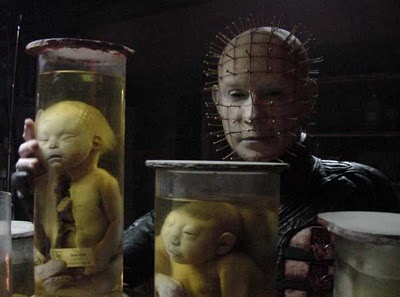I can’t figure out whether I hate or admire Hellraiser: Hellworld.
On the one hand, it’s a well-intentioned deconstruction of the horror genre and Internet culture, circa 2005. On the other, it’s the eighth film in a horror franchise, and the fourth to go directly to video; so it’s likely that I’m not writing about great art.
In the movie, Hellworld is the name of a wildly popular computer game based on Clive Barker’s 1987 classic, Hellraiser. Players jump on-line and navigate their way through the labyrinth of hell, trying to avoid the sadistic, disfigured cenobites. As the film opens, a number of teens attend the funeral of their friend, Adam (Stelian Urian), who became so obsessed with the game that he dug a trench in his basement and lit himself on fire (I guess it was less expensive than springing for the expansion pack).
A few months later, Adam’s friends each win invitations to attend the legendary Hellworld party, an orgy of booze, sex and house music exclusive to masters of the game. Chelsea (Katheryn Winnick) is reluctant to go, believing that going to the event would be in bad taste—but she gives in to her gang of annoying friends and allows the rest of the movie to happen.
The bash takes place in a gothic mansion that has been tricked out with architecture resembling the famous Hellraiser puzzle box, a brass-and-wood bauble that opens the doorway to other dimensions—but mostly to hell. Through the haze of pot smoke and the best/worst extras-in-a-party-scene dancing you’ll ever witness comes The Host (Lance Henriksen). He welcomes the revelers, offers them drinks, and invites them to explore the house.
It’s right about here that Hellworld unapologetically abandons the point of the Hellraiser franchise and becomes a cross between a slasher movie and a Saw knock-off. We’re treated to a series of drawn-out vignettes in which Idiot A wanders into a room filled with really dangerous-looking equipment, says, “Gee, what’s this?,” and ends up getting beheaded/disemboweled/nearly decapitated. Because the music’s so loud, no one hears any of this; meaning that idiot B can follow a steamy seductress into the basement for sex, wind up getting locked in another room with really dangerous-looking equipment, and say, “Gee, what’s this?”
The slasher part of the equation, oddly enough, is Pinhead (Doug Bradley). For Hellraiser die-hards, the coolest thing about the lead cenobite—besides, you know, the pins—is the fact that, in the earlier films, he and his demon crew would enter a scene with great fanfare and drag unlucky assholes back to hell. Their arrival was heralded by composer Christopher Young’s majestic doom score and odd visual cues of reality bending to make way for another universe bleeding into our own. In Hellworld, Pinhead pops up from behind bookcases and lab shelves and chops people’s heads off with a meat cleaver.
This is the kind of movie where the mind is free to wonder about things like why the license plate on the teenagers’ truck switches inexplicably from Canadian plates (or maybe Bulgarian) to New York ones, or why the Chatterer cenobite is back among Pinhead’s posse when he was clearly destroyed at the end of Hellraiser 2. It’s not a film that evokes electrical impulses in the brain.
Until the climax.
If you’re actually going to rent this movie, you may want to pause and come back to this review when you’re done. At the three-quarter mark, when Chelsea and her last surviving friend, Jake (Christopher Jacot), are on the run from Pinhead, they discover that The Host is actually Adam’s father. He’d set up the Hellworld party as a death trap for the people he believes enabled his son to kill himself. This is no surprise to anyone who watches movies with Roger Ebert’s Law of the Economy of Characters tucked away in the back of their heads; but there’s a further twist.
The Host actually drugged Adam’s friends at the beginning of the party and buried each of them in shallow plots at the back of the property. The drug was so powerful that it caused a group hallucination, wherein everyone thought they were being killed by Pinhead and the cenobites.
I won’t reveal the third twist because it’s really lame and places about sixth in Hellworld’s nineteen different endings. But I want to talk about what the second twist means for the rest of the movie.
I’ll set aside the fact that, from a meta standpoint, it’s kind of ridiculous that a good chunk of the movie Hellworld is meant to be a single hallucination being had by six different people locked in coffins (if I’m dreaming about my friend being killed, for example, why would I be crying on the phone to my other friends because I don’t know what’s happened to him?). The genius of the movie’s conceit is that it retroactively makes every one of its problems not problems anymore—from all the shitty acting (a good deal of it coming, sadly, from the barely awake Doug Bradley), to the bizarre, film-school-quality camerawork, to the wholly uncharacteristic actions of Pinhead.
That’s to say that if the truly awful parts of the movie are just the trippy dreams of stupid teenagers, then the movie itself is not necessarily bad. It may be unpleasant to watch Lance Henrikesen actually pop up and say, “Boo!”, but in the context of feverish hallucination, I’ll buy it. Maybe in a narcotic state, the mind turns everyone’s mannerisms and line deliveries into a series of One Tree Hill audition tapes. I don’t know. It’s possible.
And that puts me back at square one. Is this movie good, or is it really fucking terrible?
Maybe I should let time decide.
Five years have passed since this snuck onto video store shelves, and there’s talk of rebooting the franchise with a big-screen remake. Yep, it’s official: Hellraiser: Hellworld is an awful, awful movie.


